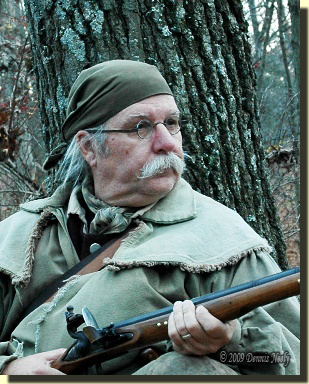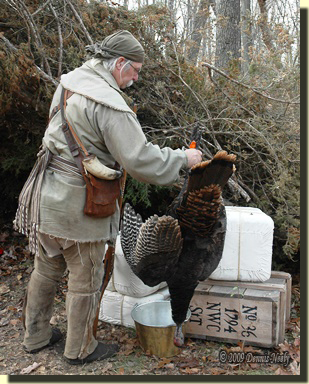Cinnamon-colored hair rippled. A white tail flicked twice. Green oak leaves fluttered, coaxed alive by a warm, southwest breeze. The doe browsed on lush, belly-deep, dew-laden prairie grass. Yellow spears burst forth from the eastern tree line. Long shadows shrouded the meadow.
The woodsman sat with his back to a modest red oak. The Northwest gun rested on his trail-worn buckskin leggins. On this late-August morn, Samuel the Trader’s hired hunter watched, learned and planned for fall’s first chilly days. It was the Year of our Lord, 1794.
The doe munched in lazy circles. She raised her head to a silent count of six. Every second or third look-about, the matron gazed at the thick underbrush that lined the grassy knob’s western border. The hunter assumed a fawn or two rested there. Plus, the spaces between the shag-bark hickory, the wild cherry and the broken-down apple tree marked the two trails used by the bucks that entered the meadow, starting in early September. Perhaps…?

Not long after, the first patch of sunlight dappled the south side of the knoll. The deer meandered that way, looking like she wanted to bed and bask in the sun’s warmth. A hungry mosquito buzzed about the hunter’s right ear. He twitched as the doe did. The buzzing stopped…then started again…then faded.
The little beastie hovered over the bare skin of his right wrist. The doe stood in the sunlight, surveying the cedar grove and the woodsman’s oak lair. The mosquito landed, took two steps, then leaned forward. With the stealth of a great backcountry provider, the hired hunter’s left hand stalked his right. Two fingers lunged. The mosquito rolled into a dark brown smudge.
With a steady cadence, the doe returned to the shadows, ambling slow to the east. To the northwest, between the wild cherry and the shag-bark hickory, another deer appeared, walking slow, showing no concern. It paused, surveyed the meadow, then chose a path a few paces west of the dark line in the silvery dew. This doe browsed as the first, lazy circles, passing in an out of the sunlit patches. At the knoll crest, another mosquito died by the same two fingers, this time on the back of the hunter’s right hand. It left nary a trace or a corpse…
David McCrea’s Crate No. 36
That 18th-century time-traveling adventure was a simple scout, a chance to get into the woods for an hour before the writing commenced. The goal was observation and whimsy, an opportunity to satisfy the call of the wild goose that beckons my soul to the forest as summer winds down.
Years ago, wedge upon wedge of Canada geese flew over the homestead on their way to a casual loafing on the River Raisin. This was exercise time for fledgling birds, and each string uttered its share of ke-honks, a haunting melody that teases my being, or rather that of the hired post hunter. Of late, the geese are few and far between, but now and again goose music reminds a lowly woodsman that the time soon will be at hand.
Joseph Doddridge captured the essence of this calling in one of my favorite passages taken from his memoir, although the weather is different:
“…As soon as the leaves were pretty well down and the weather became rainy, accompanied by light snows, these men, after acting the part of husbandmen, so far as the state of warfare permitted them to do so, soon began to feel that they were hunters. They became uneasy at home. Everything about them became disagreeable. The house was too warm. The feather bed too soft, and even the good wife was not thought for the time being a proper companion. The mind of the hunter was wholly occupied with the camp and chase…” (Doddridge, 98 – 99).
A few days ago I grabbed Jonathan Alder’s journal from the shelf in response to a living history telephone conversation. As an aside, I heard Canada geese ke-honking as they passed over the homestead—how appropriate. After finding a specific passage to illustrate a point, I set Alder’s journal to the left on my desk. An afterthought with regards to that discussion sent me leafing through the narrative in search of Alder’s adoption account, which is standard fare in almost all captive recollections.
As so often happens, the search for an answer to one question either poses another or produces an unexpected golden nugget. Such was the case with the cleansing preparation for Alder’s adoption:
“…The day before the adoption, my Indian mother had gathered a large amount of herbs of various kinds, and that morning she put them into a large brass kettle and strained the water all out and cooled it to about blood warm. Then, she took and stripped me stark naked and commenced rubbing me with soap, some of the finest British soap that could be bought…” (Alder, 45).

In “Crazy Thought Time…” I posted about the two fur-trade crates I made some years ago. The emphasis was on crate No. 47, which contained iron goods. Over the years, that crate’s contents have formed the basis of several published works. Not once have I given due consideration to the contents of crate No. 36: “84 lb. Castile Soap.”
For multi-day traditional hunts, the hired hunter carries a small linen sack with personal items, which include half of a four-ounce bar of Kirk’s Castile Soap. The company dates back to 1839; not quite 1790, but close. I have a daughter who makes soaps, so perhaps in the future a raw bar of homemade soap will replace the modern variety.
To put this quantity in perspective, at four ounces per bar, that’s 336 bars of soap. Count the bars on your grocer’s shelves to get a better picture of this volume of soap. Of course the fur-trade-era soap did not come in a fancy package, have rounded corners or the company logo stamped on both sides. And oddly enough crate No. 36 is about the right size for that quantity of bars with room for straw packing.
A quick search of other trade inventories or clerk’s ledgers finds no mention of soap or the trading value of that commodity, expressed in peltry. More research is required, which is part of the fun of living history—and part of the frustration, too. Thus, one answer generates one additional question. In addition, James A. Hanson’s The Encyclopedia of Trade Goods Volume 6: Provisions of the Fur Trade offers a brief discussion of soaps available in the trade, but again, no values.
In such situations, I tend to get down on myself for missing such an important detail, but this is not the first time, and it won’t be the last. However, the value of this little golden nugget rests in the use by Alder’s adopted mother and the fact that she prized “some of the finest British soap that could be bought…”
This discovery opens the door for Msko-waagosh to possess and/or use British trade soap or an American variety. As Mi-ki-naak’s material culture is developing, it is clear that his adoptive family dealt with the French traders. So the French journals might hold an answer.
And if Mi-ki-naak takes on the mantel of an aged hunter reminiscing of his exploits in 1763, then his only option is British trade goods available at the year of telling. Oh, my, another issue that must be solved. For now, I’m satisfied with learning about the finest British soap that was shipped in crate No. 36.
Give traditional black powder hunting a try, be safe and may God bless you.


